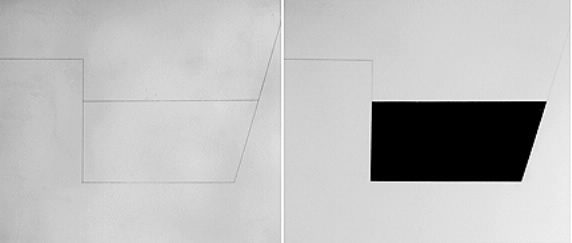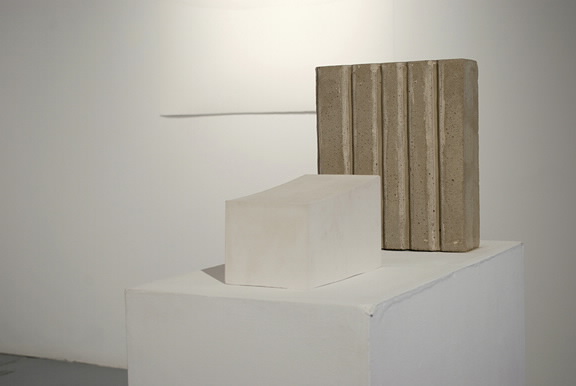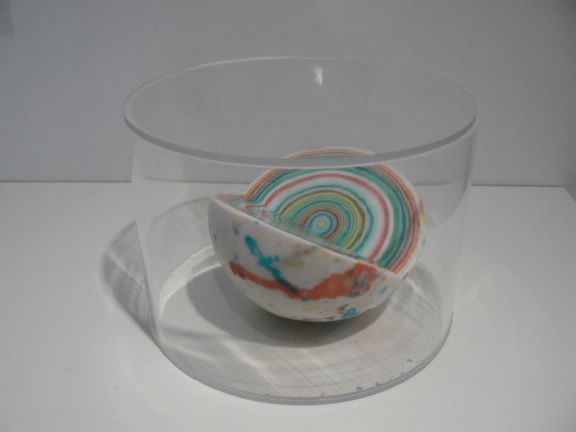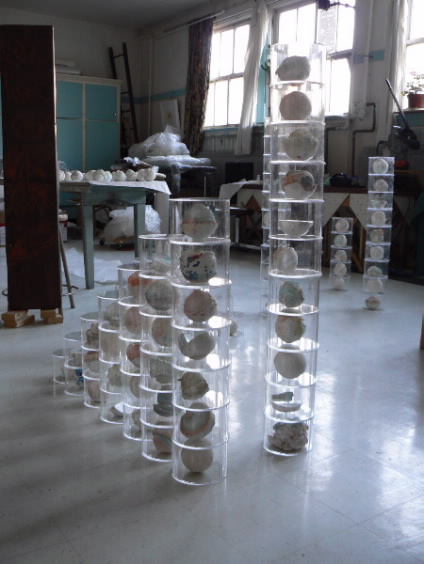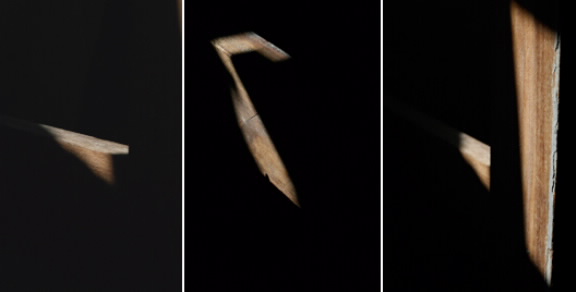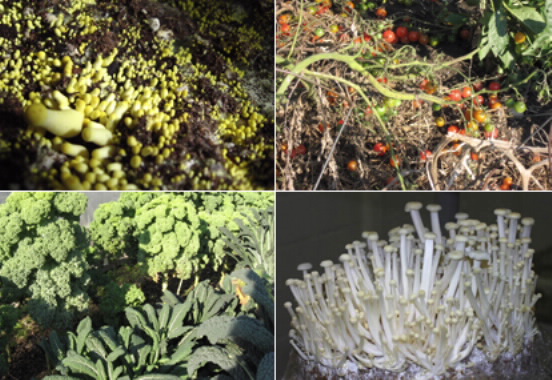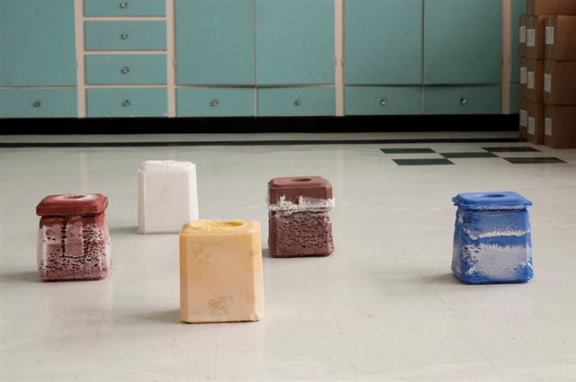| view Scribd version (PDF) | |||||
Castings: A Conversation With Deborah Margo (DM), Bianca Scliar Mancini (BM) and Janita Wiersma (JW)
When we first invited the artist
Deborah Margo to contribute to this issue of
Inflexions, the proximity between the concerns raised in her works
and our own practices motivated us to embark on the conversation you
read here. Rather than conducting our curiosities through
a traditional “question and answer” format, we developed a
structure in which blocks of ideas were exchanged between the three
of us, developing a flow of conversation that allowed us to trade projects,
references and questions. What we share here is a compilation
of this process, which occurred over the course
of three weeks. Materiality JW: What
first drew me to Deborah’s work were the site-specific Light-Earth
Drawings made in a stairwell at Mount Allison University in Sackville,
New Brunswick. The drawings were so slow and unobtrusive that
they had to be looked for and, once found, there was a desire to catch
the light and drawing in alignment. I felt myself as a third in
the space between passing light and physical trace. Usually when
using the stairwell I would simply pass through it, but encountering
the deliberate marks on the wall, I felt myself moving with it.
The shape of the windowed stairwell, the tall casings, the expansive
space of the architecture was asserted into my field of movement as
a subtle choreography. I felt the flow of traffic, which
was the light recorded, enter the space and be mirrored by the moving
bodies. In this work, I felt time shaped by Deborah’s pigment.
The passing lights move on even as they are recorded, embedding a feeling
of pastness to the present looking. Something was once there,
the artist has left me proof – but the traces are not conclusive. I am sharing with
you both some images from Spacious Object, a show I had recently
at Galerie Les Territoires in Montreal, Quebec. With this work
I was aiming to create abstracted fragments of things seen: fields,
concrete structures, shadows, ripples on water. What I was looking
for in each piece was a feeling of spaciousness and time slowed down
in the traces of what was, much as I felt it in Deborah’s Light-Earth Drawings. Abstraction is a way for me to slow the process
of recognition so that the exchange between viewer and viewed has a
chance to develop. Reservoir 2 and Reservoir 3, Intaglio etchings, 14x13”, Janita Wiersma, 2009. Fragments, cast concrete and plaster, approx. 12x12”, Janita Wiersma, 2010. DM: Many
thanks for your sensitive writing about the Light-Earth Drawings in Sackville. Where to begin?
First off, nothing is immobile. Everything is constantly changing -
whether we notice it or not. Art making can be a way of trying to slow
time down for oneself or to at least attempt to be aware of its intransigence.
Potential movement? As the recent earthquake in Ontario and Quebec reminded
many people, rather it is our perception of the constancy of movement.
We tend to want to believe things can be at a standstill, but they aren’t,
even when you are stuck in traffic and it appears nothing will ever
change. Light too, is
constantly changing, shifting. The light interventions have been about
recognizing this and the puny attempt to fix it in a drawing, while
knowing its patterns have already moved on to other configurations.
Movement becomes much larger than what I have traced; sun, earth axis
and turning. I have paper forms of some of the shapes the sun has taken
as it passed through a window and made patterns on the floor, made in
Sackville many years ago. I’ve wondered what would happen if I made
them into solid forms and then placed them in a space without windows
(a typical gallery situation). They look like these modernist configurations;
cast in concrete they would take on a further muteness (as in dumbness),
but yet they derive from something so alive and fleeting. Roland Poulin’s
early concrete works appeal to me for the same reasons, far from the
drama of so much of his more recent work. BM: Deborah,
I see you less as a collector than a provoker of set-ups, challenging
the materials to respond to the ‘chemical’ or physical encounters
you propose. Nevertheless, these choreographies remain unseen - the
performance between materials is left to the viewer only as traces of
changes. It seems to me that you’d almost pick the ‘wrong’
tool just to radically experiment how an unusual interaction would change
the surface of things, or to explore how the friction would unfold the
substance and challenge the notion of essence. JW: What also stands out for me is the idea of the artist being located ahead of the work. I think Deborah touched on this positioning when she wrote that she is interested in provoking a series of events – to precipitate the process - without necessarily knowing the outcome. This location ahead is intriguing to me because it is the place I often find myself working from, as well. The sensation of physically making real a vague image or idea is like being further along than the work itself; as though I have already reached the place where the work is, and now must discover the materials and lines to give it a form. DM: Certainly
there are materials outside the more traditional art lexicon that are
waiting to be used, mined and explored. I don’t go intentionally looking
for them, but have never felt bound by one specific material I wanted
to stick to. Over the years the list of stuff I have worked with has
grown, but what has remained consistent, are the issues, some of which
we are addressing here. Janita, how did you decide upon concrete for
(some) of your sculptures? I find it is a material people either love
or hate (both artists and viewers). You? JW: I enjoy working with concrete because of its colour and weight. When
beginning these sculptures, I wanted something that replicated the city,
in its blankness that is not really a blank. In opening up my casts
I always discover pockets of air, rivers of subtle colour shifts, and
the minute detail of the surface of my mould. There are lines that cannot
be entirely straight. Concrete is a material that though it first
appears as impenetrable and permanent, it cracks and erodes just as
everything else. DM: I was challenged by the artist Stephen Schofield this year about my
putting my work on the floor, so I have been rethinking my insistence
on not using podiums. I am curious to know how you decided to
install your work that I am catching glimpses of through your documentation.
I love the idea of the reservoir as used in your print titles and its
manifestation in the images. I too have used it for an installation
I made once upon a time. It’s filled with associations. BM: I
am inspired by your remark of “axis turning” — I have been thinking
a lot about suspension and what it means to be suspended — does movement
always imply the existence of an axis? How does the use
of podiums relate to the idea of axis for movement and notions of time
and memory? I have the feeling
that podiums are often-unnecessary axis for directing movement around
a work/object: a suspension that directs the object into a specific
movement towards the viewer. Sometimes we need to prescribe this relationship,
but most often it is just fear and control taking over. JW: I did use sculpture plinths, but wasn’t entirely satisfied with the height. I haven’t resolved this. In some ways I like the supposed neutrality of a 3-foot podium, but of course it isn’t really neutral, and yes, I think the impulse to use it is based in a need to control the posture of the body, and the ways of seeing, more than actually opening the work up to other possibilities. What were the comments directed at your own placement of your Giant Okeydokes on the floor? DM: Comments
on the Okeydokes being on the floor were that they are at too
much of a distance from the viewer, do not engage the body enough, that
there is a role to be played by the podium or other such devices in
allowing the work to be closer to the eyes and the mid-range of our
bodies. I have spent so much time thinking about ways of presenting
work without such bug-a-boos that I am now actually curious about further
alternatives including what is the role a podium-like device can hold.
Last fall and onwards, the Okeydokes were exhibited in presentation
boxes I had made out of acrylic. I will send you both pictures when
I am home once again. Working with these presentation boxes allowed me
to stack them in columns and other configurations. They have now been
tried out in three different exhibitions and have led to other possibilities.
I have also sunk large magnets into them which allowed me to affix them
to walls, ceilings and onwards. Certainly their sense of gravity in
these various situations has been different, allowing for a better sense
of their orb-like form. But I still like the idea of someone bending
down and picking one up - which people do - or lowering oneself down
to the floor to see the work closer! Is this my being too much of a
control freak? Interestingly, when the work has been in straight lines
on the floor, children have felt very comfortable moving through it. Giant Okeydoke in acrylic casing, Deborah Margo Giant Okeydokes, Deborah Margo BM: I agree that the podiums already set a relationship - with the eyes - but they create a suspension and a frame, which is interesting when you say they are surrounded by acrylic, because it is a frame that doesn't isolate visually from the surroundings.
Deborah, you mention
your surprise when things remain and I’m thinking that permanence
and our inability to recognize things in their constant changes is connected
to our need for an essence of things. The idea of casting a shadow
addresses this question, in my point of view. A shape created by cast
light originates as an object. It is not the light anymore, but
the trace of a trace: the permanence of a constantly changing ‘thing,’
trapped into a permanent shape. Photographs of Light, Bianca Scliar Mancini, 2010. JW: The density of marks in the broken link you encountered, Bianca, reminds me of Agnes Martin’s grid paintings. Here again I feel as though there is both a fullness and an emptiness, working together to describe the indescribable. We give form to the formless, always working on the edge of something that can’t quite be written about, can’t quite be drawn, captured, shown. But we can give an impression. The container gives shape to an inside and an outside. Lines create borders between something and nothing. DM: Agnes
Martin. I have such respect for her work although it is very different
from where I come from. There is a search for perfection that is far
away from the messiness of daily living which I deeply love and wonder
about. You see the "messiness" also has such a vital presence
in art and I don't want to deny it – it’s what makes things feel
alive. But I also love the moments of contemplation that Martin
offers. BM: Janita,
the drawings from your Spacious Object project are so elegant
- they remind me of Bianca Tomaselli, a young Brazilian artist’s,
work. Maybe because of the straight lines and the cleanness of
the shapes, but mostly because you both revert the principal of constructivism,
each in your own manner. Tomaselli raises the feeling of impossibilities,
since she draws with hair and a straight line is never a perfect line
- it is almost like setting yourself up for an impossible task. Gardening
is also about this effort of arranging and combining forces of nature,
of nurturing, playing chess with the responses and with chance. You,
on the other hand, by playing between two and three dimensions (evoked
by Deborah when writing about shadows) construct lines that are organized
in such a way that instantaneously become containers: the essence of
bordering and holding, and giving shape to whatever matter that otherwise
would leak, formless. If you can
put your five fingers through it, it is a grid (Study 1 and 2), Hair on Fabriano paper, 7x5”, Bianca Tomeselli, 2008. Gardening DM: For
the past six years I have been working in the summer as a gardener.
This year I have more than twenty clients and am working outside steadily
from mid-April (when classes ended at the University of Ottawa where
I teach part-time) until the end of August. The smallest gardens have
been planting pots or tending to a small strip outside a condo project
whereas the largest are elaborate gardens situated next to the Ottawa
river. Some are of my design, others are tending to someone else’s.
I am immersed in plants and their changes, though I don’t think this
can be called nature. Gardening is about making all sorts of environments
– installations? – following different clients’ needs. Artifice
and artificial, most certainly. Yet the cycle of plants does belong
to nature. Seeds have germinated or root systems have revived. Some
I have helped along, a great many have their established cycles taking
pretty much care of themselves. We have passed the mid-summer point
and I can already see the signs of the growing season moving along to
its inevitable end, returning to dormancy. Life/death/life/death… They
are part of the same thing, not macabre, just a fact whether I choose
to pay attention to it or not. And for me that is the point – wanting
to pay attention (for lack of better words) to what is going on right
in front of me. The images attached
are from one of the gardens I’m working on. Erich is a pack rat of
the severest of kinds, yet he has asked me to reclaim a garden strip
at the back of his yard in an Ottawa suburb. The plot I’m working
on is about 2.5 meters by 25 meters and is reached by a narrow path.
Every week, since May, I have worked a couple of hours, discovering
all kinds of perennial plants that have been spreading for many years,
clearing spaces for the ones I’m selecting, adding new ones. The over
growth and embedded objects are a challenge – should they be left
as is or “cleaned” up? What is the balance between my supposed civilizing
and letting things just be? What is a weed? What is a desirable plant?
And what about the tree seedlings Erich has let grow rampant, yet he
claims he wants to have a lawn again! Erich’s garden, Deborah Margo, 2010. JW: The
challenge you talk about regarding Erich’s garden reminds me of the
process of making art, too. How much control do the materials allow
you to have? How do you know when you have reached the point when you
should stop working? Are the saplings that grow up the birth of something
new, or just a remnant of an old thought that needn’t be kept around
anymore? I have attached
a collection of images (mushrooms, kale, succulents) that relate to
Deborah’s Giant Okeydoke series. There is something grotesque
about these disintegrating balls of sugar, but also gorgeous. In their
state of decay the jawbreakers remind me of things growing, expanding,
opening. Collected Images, Janita Wiersma DM: I am intrigued by the plant images you have collected. Are some
of them pictures you have taken, others you have found? There is the
mundane – the fall tomatoes, the kale and broccoli, as well as the
more exotic (in this part of the world, anyway) of the fungi and the
living stones. It is so curious
that you have made a link between gardening and the Okeydoke series – so do I. Something small but fantastical. Also something
still changing. They are ephemeral works. I don’t know how long they
will last, though the hardened sugar has stuck around longer than I
expected. Still, it easily reacts to water/humidity, potentially continuing
to “bloom” and “cloud” over, though the lacquered, sanded surfaces
have stayed clear so far. JW: The mundane images, as you say, are ones I took myself at my parents’ farm in Southern Ontario, the rest I have collected from other sources. Yes, it’s the slow pace of things growing, as well as the spectacle of plants seen up close that refers me back to the Giant Okeydokes. Growth can seem so slow but then suddenly the plant has become something else entirely. I imagine the experience of looking at the jawbreakers evolve over time is a similar process of discovery - time manifest in remarkable points. Community BM: Deborah,
I would be interested in hearing about your community-based projects
and other sorts of collaborative practices and how they relate to my
seeing you as a provocateur of relations between bodies/materials.
I would like to learn from you about the one big question that’s been
chasing me lately: when and how do these practices become an artwork
and when do they remain in the realm of experience that informs your
perception as an artist, but are not directly art? When does gardening
conform to an art practice, or a piece, for example? What is the role
of the artist in relation to community and social issues? Should we
be more responsible than a dentist, for instance? DM: I
have worked on a number of collaborative projects over the years and
enjoy doing so every once in awhile. They are tough to do and demand
great amounts of trust with those involved and the possibility that
there will be no final outcome or so-called result. Generally, the conversations
and the sharing of ideas are what I find the most exciting and intellectually
nourishing. The most recent project of this sort was with Devora Neumark
(Why Do We Cry? Lamentations in a Winter Garden - there is a
fair amount of information on it if you look it up on the net.) For
me, I would say this project was definitely pulling on various definitions
of what is art and put me on very shaky ground in my thinking. Having
work at the Toronto Art Fair at the same time was a travesty in terms
of different contexts! In Toronto, the convention center was filled
with acres of objects that would be called “art” at the same time
as there was an economic melt-down, while in Montreal I witnessed the
local “residents” in various states of deprivation who were also
an important part of the group participating in the project. I think
my experience of the project and Devora’s were completely different.
To date it has made me turn once again to object-making and yet I continue
to question where my work belongs, and this at a time when I have had
a fair number of experiences showing in a variety of so-called art contexts
i.e. commercial galleries, public galleries, artist-run spaces, independently
organized projects in non-art spaces… Another community
project in which I grew scarlet runner beans over the course of six
months was in the realm of art practice. Nevertheless, I think a lot
of the gardening work I do does not conform to the conventions of an
art practice. And yet there are other parts that seem to fit perfectly
i.e. the notion of different parts and their relationships mattering
far more than single works or gestures; the attention to context being
paramount; the notions of change we have been talking about since the
beginning of our conversation; how one moves amid or through an art
work. Gardening helps me with the installations I make / the installations
I make help me with the gardens I work on. Yesterday I visited
a sculpture exhibition taking place in Confederation Park here in Ottawa.
All very laudable goals having to do with recycling of materials considered
by a group of mid-career and emerging artists, yet the work was terrible
and the presentation of it even worse. I had to think what made it so
bad, when the written descriptions spoke of such terrific intentions.
All of the work sat on dead grass and was set out in a perfunctory fashion
with about the same amount of space measured out between each work.
It’s the old story of things speaking rather than doing or “I am
telling you what I am about rather than evoking something for you to
experience if you so choose” while not addressing where they were
placed or shown. The sculptures did not do well “out in the world”,
so I have been thinking what would allow them to be outside and resonate.
I saw one of them on the roof of a car today with the vehicle moving
through town – this was already a great improvement. And this brings
me to your question of what is the role of the artist in relation to
community and social issues. Though I have started working on another
community project here in Ottawa, I am still ill at ease with the role
of the artist in such a context. Once again, the group conversations
on the possibilities for a project on food production have been terrific,
but I do not where all the wonderful talk will go. Are we another group
of do-gooders? Are we feeling guilty about the old myth of art’s lack
of function in a world of accountability? Is there a link with the other
projects that I have been talking about with you and Janita? Does there
need to be? What do you do with the notion of art being an elitist undertaking
unless it is based in a community practice? I am wary of such dichotomies. The dentist provides
a specific service for their clientele. When I garden I also provide
a particular service that is usually set by the client’s needs. An
architect’s work is also most often bound by such a relationship.
Art-making has the possibility of being in a different realm. When I
am working in the studio I am most often researching possibilities of
different issues or problems I am curious about. I do not know the outcomes,
but I know I am working towards finding something. Investigation? Something
akin to being in a laboratory? There is a need for results somewhere
along the way and these I eventually choose to share outside the studio.
The opportunity of this conversation allows me to know these issues
are not mine alone, but are also shared with others including the two
of you. In fact, there have been multiple points of connection which
I love. I think I have
come closest to understanding my responsibility as an artist when I
am in a teaching context. I have a certain set of experiences that can
be shared with others and in that sharing students will interpret them
according to their own needs. I do not teach to have students necessarily
become artists rather I hope to have them learn more about what it means
to think creatively. I do believe this notion can be applied to anything
one does. How do we problem solve? How flexible is our thinking? Are
we able to consider an argument from a number of points of view? What
happens when good or bad/I love or I hate are irrelevant? What allows
the dentist to strive for the best at what they can be and do? JW: I don’t have much experience working on community based projects as
an artist. I’m involved in community in many ways, but I don’t participate
as an artist necessarily. Or I do in part, but not with the goal of
a completed project at the end of the process. The questions that have
come up around the role of the artist are definitely ones that I consider
as well, especially when preparing to mount a show. What is my responsibility?
The gallery space is a difficult one for me because it can be such a
place removed but I also love it for the remove it can provide. I suppose
this question about the role of the gallery is very similar to the discussion
we have had about how to use or not use plinths for display. I think
my sense of responsibility as an artist is no different than the responsibility
I feel as a person in the world. I don’t want to alienate people or
make them feel unsafe. I aim to offer a space that is open enough that
many ways in and out are possible. Much like a conversation, I hope
that ideas and points of connection proliferate. I am still turning
over this question of role and responsibility and how actions spill
over into art. Memory / Traces BM: I
would like to think about where do we place ourselves in this process
of trying to reach time and its traces. Are we located always ahead
the setting that is observed? This is where I think Deborah’s work
differs from ‘remembering’: it is about memory but placed ahead,
looking at the body of things and how they survived the flow of time.
How do you see your work enunciates qualities of memory? What are the
relations you seek between that which remains and the invisible, the
potentialities? Where are you
in this flow of time and change? Have you ever showed the procedures/performative
interactions between materials in a gallery setting? I am intrigued
with the allusion to emptiness, because of the nature of the gesture
of constantly capturing change. Where is emptiness or void? Isn’t
vanishing instead of a synonym for disappearing, closer to changing: transduction? DM: Good
question about where am I in the flow of time and change in the situations
I set up. I do take some responsibility in provoking a stream of changes
in the sugar and salt works and also have some control over when they
can come to some point of stopping or freezing in their deterioration.
Inevitably the work will return to being dust one day which I am fine
with. I don’t take much stock in the permanence of art works. Not
much of a surprise there, I guess. Yes, I have been interested in the
procedures/performative interactions being made more public. I have
made preliminary designs where a sugar ball /okeydoke would be slowly
transformed in a gallery setting, but so far none of the spaces where
I applied to show such a project have bitten! A slow stream of water
would bathe the ball of sugar and collect again below it, forming a
new work. Eventually the original form would no longer exist, but its
residue would become something new. I have also grown scarlet runner
beans on structures/supports made from what I found in the garbage and
am often in conversation with people living in the surrounding area
commenting on the growth of the plants over a period of six months. I’m not sure I believe emptiness
is really possible. Transduction –
what does this mean? I would understand it as a process where one type
of energy is converted into another. We may not see it with the eye,
but we nevertheless know that it exists. Not surprisingly, this does
interest me greatly. Energy is a constant - it is a question of what
shifting forms it takes. BM: I am referring to transduction as it occurs in Gilbert Simondon’s work. According to Andrea Oliveira, who has been writing recently on Simondon: “Transduction is a chain transformation between participants from the same system, from the same associated milieu, which can occur in a micro or macro molecular level. It takes place within participants who previously find themselves connected within a system, whom, as the transformations occur and propagate, are changed. In other words, changes that re-conform the constitutive participants themselves. Such a chain transformation is structural and composes the operating mode of the system, in return. According to Simondon , ‘for transduction we understand an operation which is physical, biological, mental, social, through which an activity is propagated gradually in the interior of a domain.’ 1 Transduction processes extrapolates the closed unity in itself and it’s identity. Simondon explains that in the process of individuation occurs a series of transductions, a progression through which the individual is revealed, but also the milieu that constituted it. It conforms a mode of production within the individual, which produces an actualization of that which is pre-individual. Art, in this context, proposes a non-deterministic mode, as if within the individual surroundings was a reminiscence of a pre-individual reality, associated to the individual, a reality that would rebound the singular with the collective. Transduction, contamination, propagation, something in formation as a continuous collective operation.” JW: This is why I love the idea of casting the drawings of captured light – I am becoming more and more interested in the idea of pushing things to their limit so that they almost spill into their opposite. Already the paper shapes you mentioned that capture the light are only a representation of the movement you were tracking. I can imagine how creating three-dimensional blocks of these drawings would provide them with a further dumbness, but perhaps also a deeper voice, simply because the opposite is always there, in everything. BM: I
am also struck by the attempt to collect traces of time passing. In
the casting series it happens in the scale of a day - so, at first you
are the one marking the points where sunlight draws shades at the window.
After you leave, it is the sun, again, that will highlight each mark,
striking the different drawings along the day. The event, which was
marked at the walls will never have the same shape again, even, and
one can notice the slight differences once the sun hits the drawings
on another day. Usually when we
evoke memory it refers to an event as a static circumstance, something
we lived, but which remains behind and that we re-visit mentally - or
re-collect. I see in your procedures something different: what does
remain? How does it link to an origin of forms, or transgress what we
thought to be an essence of the material? I would like to
provoke you and ask about whether you understand your practices as time-capturing
procedures? JW: I love the idea of time-capturer. In Deborah’s work the net is cast
wide and what is caught is a process of disintegration - transduction
- that occurs so slowly that it almost appears to be immobile. A moment
is captured, but it cannot be held because the third, this middle force,
urges the process onward. BM: Although
I see the attempt to display that what remains, it is the opposite of
claiming for an essence of things (which I mentioned in an earlier correspondence).
It is only the abilities to give, to let parts of it dissolve that allow
some force in the middle to emerge to the surface (an interior axis?).
Memory, in this sense, is about physical modification and not recollection
of a set of circumstances. DM: I
agree with your definition of a memory and its evocation, but I am not
certain it is of static circumstances. Rather it is a gathering of moments
that for some reason we have deemed important to us. Some see the memory
as an exaggeration or a fiction, but I am not convinced. Certainly it
is selective. I have lived with the same person for close to thirty
years and what he chooses to remember and what I do, about the same
circumstances, is completely different. And yet I also know, based on
experience, that many of my memories of particular individuals – their
smell, the sound of their voice, how they hold themselves – are more
accurate than I thought possible. Sometimes these memories have shocked
me in how they have sustained particularities of another person when
I see them after many years. Yes, I am interested
in how the event changed the body or object that experienced the event
– it remains the same, but also different. A summation of its original
manufacture, how it has been changed and yet continues to exist. I am still working
on understanding what you mean about being located ahead of the setting
it is observing. Do you mean the work anticipates its own changes before
they happen? Perhaps not, but I will wait to hear back from you, Bianca.
I do hope for a conversation between the materials I choose, the stress
they undergo and my decision-making – a series of events that I try
to precipitate without necessarily knowing their outcome. Eventually,
when it becomes endlessly predictable, I move on. This came up in a
lecture I participated in last year with the artist Eric Cameron. He
is satisfied with repeating the same events over and over again for
years on end, while also not knowing the form of the outcome, yet he
sticks, pretty much, to the same materials (paint and gesso). I think
I am more restless. What was there.
What has changed. What has become. All three states are co-dependent. BM: I am
curious: Can your sculptural pieces be touched, manipulated by the audience? DM: Three-dimensional
objects most often ask to be touched. I, for one, tend to understand
a great deal about the world through my finger tips. As always, whether
someone chooses to touch my work will largely depend on the context
where they meet it. Once a series of sculptures I made were set up on
casters; every time I would visit the gallery, all of the work had been
moved by the audience despite there being no sign inviting them to do
so. I tend to take the audience’s manipulation of the work as a sign
that they have been interested in it, despite when they have been admonished
by a security guard or gallery owner! I am sending here some images
of recent work: large salt lick blocks that have been immersed in water
for varying periods of time. Salt Licks, Deborah Margo, 2010. Salt Licks, Deborah Margo, 2010. BM: These are so beautiful!
What are salt licks? The image of corrosion is such an interesting
way of, once again, framing time and memory. DM: Here is a definition about what a salt lick is, straight from the internet: “A salt lick
is a deposit of mineral salts used by animals to supplement their nutrition, ensuring that they get enough minerals in their diets. A wide assortment of animals, primarily herbivores,
use salt licks to get essential nutrients like calcium, magnesium, sodium, and zinc. When a salt lick appears, animals
may travel to reach it, so the salt lick becomes a sort of rally point
where lots of wildlife can be observed. Farmers have
historically provided salt licks for their cattle, horses, and other
herbivores to encourage healthy growth and development. Typically a
salt lick in the form of a block is used in these circumstances, and
the block may be mounted on a platform so that domesticated animals
do not consume dirt from the ground along with the necessary salt. Salt
blocks for farm animals can also be treated with medications, which
may be convenient when someone needs to medicate shy animals, or a large
group of animals. Some people
also use artificial salt licks to attract wildlife such as deer and moose,
along with smaller creatures like squirrels. Animals may be attracted
purely for the pleasure of the humans who install the salt lick with
the goal of watching or photographing animals around the salt lick,
and they are also used by hunters to encourage potential prey to frequent
an area. Wildlife biologists may use salt licks as well, to assist them
in tracking populations, and wildlife salt licks can also be medicated;
deer, for example, might be fed birth control to keep them from proliferating
in areas where there are few natural predators. The universal
popularity of salt licks with a wide range of animals illustrates the
ways in which wildlife naturally seek out nutrition which is essential
to their survival. Salt licks can also provide nutrition for predators,
in the form of conveniently-located prey who may be distracted by the
salt lick long enough to become a snack.”2 Are you okay with
art works being “beautiful”? Today, often in contemporary art, I
find it has become like a four letter (swear) word, something to be
embarrassed about, an insult, or having a subversive connotation. Strange.
I understand your use of it being something else altogether – that
it is possible to be visually attracted to art works and this is a positive
experience. It is not what I look for necessarily when I look at other
works, but I believe it definitely has its place. It can act as a lure
for an art experience to unfold into further connotations, associations,
meanings, other possibilities. Yes, that would be my hope in making
something beautiful. JW: The
transient way that the Okeydokes, salt licks, and even the Light-Earth Drawings capture a moment seem very much akin to memory
for me. I agree – memory is not static, but rather a process that
occurs in the present. We don’t return, we create anew with threads
of thought that have moved with us all along. In Deborah’s work the
gesture of adding water is a memory in process, continually renewing
itself in the present moment. We had milking
goats when I was growing up and there was always a maroon salt lick
in the corner of their pen that we used to check up on to see its progression
from square to pock marked form (and sometimes to steal a taste). The
goats would slowly carve the block out with their rounded licked hollows
– it was a beautiful object especially set as it was on an overturned
pail in a pen strewn with straw. The process I watched the goats engage
in reminds me of the project Gnaw by Janine Antoni where she
shaped a block of chocolate (and one of lard) with her mouth. Clearly
for the goats this is an instinct to gather nutrients from the block
to thrive, and perhaps the same can be said for the impulse to create
art – it provides the opportunity to thrive. DM: A wonderful summation touching on many of the issues the three of us
have been writing about. Many thanks for this, Janita. Also thanks for
bringing in Janine Antoni’s work. I am very grateful to both of you
for the conversation we have been having. JW: Thank you both for
all you have said - I have enjoyed this conversation very much. BM: Thank you both for
the inspiration. Notes Simondon, Gilbert. A Gênese do Indivíduo. In: Cadernos de Subjetividade – O Reencantamento do Concreto. São Paulo: Hucitec/EDUC, 2003, p.112. Free translation |
>> Table of Contents edited by B. Mancini, J. Weirsman Healing Series Brian Knep 276-278 R.U.N.: A Short Statement on the Work Paul Gazzola 279-282 Castings: A Conversation Deborah Margo, Bianca Scliar Mancini and Janita Wiersma 283-308 Matter, Manner, Idea Sjoerd van Tuinen 309-334 On Critique Brian Massumi 335-338 Loco-Motion Andrew Murphie 339-341 An Emergent Tuning as Molecular Organizational Mode Heidi Fast 342-358 |
||||
